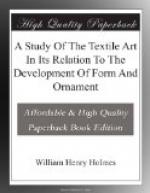In a similar way four other bands of narrow open work are introduced, two above and two below the wide band. These are produced by leaving the warp threads free for a short space and drawing alternate pairs across each other and fixing them so by means of a woof thread, as shown in the cut.
Examples of netting in which decorative features have been worked are found among the textile products of many American tribes and occur as well in several groups of ancient fabrics, but in most cases where designs of importance or complexity are desired parts are introduced to facilitate the work.
Superconstructive features.—These features, so important in the decoration of fabrics, are the result of devices by which a construction already capable of fulfilling the duties imposed by function has added to it parts intended to enhance beauty and which may or may not be of advantage to the fabric. They constitute one of the most widely used and effective resources of the textile decorator, and are added by sewing or stitching, inserting, drawing, cutting, applying, appending, &c. They add enormously to the capacity for producing relievo effects and make it possible even to render natural forms in the round. Notwithstanding this fact—the most important section of this class of features—embroidery is treated to better advantage under color phenomena, as color is very generally associated with the designs.
[Illustration: Fig. 311. Open work design embroidered upon a net-like fabric. From a grave at Ancon, Peru.]
One example of lace-like embroidery may be given in this place. It is probably among the best examples of monochrome embroidery America has produced. In design and in method of realization it is identical with the rich, colored embroideries of the ancient Peruvians, being worked upon a net foundation, as shown in Fig. 311. The broad band of figures employs bird forms in connection with running geometric designs, and still more highly conventional bird forms are seen in the narrow band.
Appended ornaments are not amenable to the geometric laws of fabrication to the extent observed in other classes of ornament. They are, however, attached in ways consistent with the textile system, and are counted and spaced with great care, producing designs of a more or less pronounced geometric character. The work is a kind of embroidery, the parts employed being of the nature of pendants.
These include numberless articles derived from nature and art. It will suffice to present a few examples already at hand.
[Illustration: Fig. 312. Basket with pendent buckskin strands tipped with bits of tin. Apache Indians—1/8.]
Fig. 312 illustrates a large, well made basket, the work of the Apache Indians. It serves to indicate the method of employing tassels and clustered pendants, which in this case consist of buckskin strings tipped with conical bits of tin. The checker pattern is in color.




